Unrealty:
Application of a 3D Game Engine to
Enhance the Design, Visualization and Presentation
of Commercial Real Estate
Vito Miliano
Perilith Industrielle
vito@perilith.com
1. Introduction
"A buyer walks into your office. He says he's interested in a particular neighborhood. Instead of driving him through that area, you sit down with him at your computer.
"You press a few buttons, and a map of the neighborhood appears. [. . .] The buyer points to one of the homes on the map, and you press another button. Suddenly, the screen shows a close-up of the front of that house. 'Here you go,' you say, handing the computer mouse to the buyer. 'Take a walk through the house.'"
-- Warren Berger, Real Estate Today, January 1994[1]
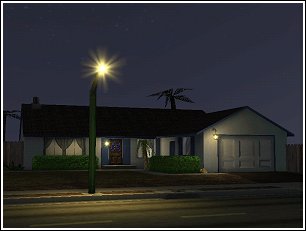 This scene was the future of real estate, rapidly approaching sellers thanks to the "fiber-optic information superhighway," and it would be only a few years before everyone sold houses this way. Over five years later, this scene has yet to be realized, particularly in the realm of commercial real estate development.
This scene was the future of real estate, rapidly approaching sellers thanks to the "fiber-optic information superhighway," and it would be only a few years before everyone sold houses this way. Over five years later, this scene has yet to be realized, particularly in the realm of commercial real estate development.
Presenting a large commercial structure in 3D, such as an office building or bank, normally requires several weeks of painstaking design to create a realistic model and have a walkthrough of it rendered, frame-by-frame. Due to the time and cost typically involved, architectural design firms primarily use 3D visualizations only at the behest of clients, and usually for marketing purposes.[2,3]
Time and cost, both to create the model and to render it, have even greater consequences in earlier stages of design. Less diversified firms rely on concept sketches and physical models most of the time, only using 3D renderings at the clients' request. Complete virtual models are rarely used at this stage; instead, single viewpoints or scenes are rendered to verify that a material or structure will "work."[2,3]
Even though the benefits of using virtual reality all the way from the design through the presentation stage have been documented, shortcomings in the technologies -- long rendering times, lack of real-time visualization, etc. -- have made using them impractical, and the lack of immediacy in the medium decreases the usefulness during the initial conceptualization process.[4]
The solution to these issues as explored here is not to use traditional CAD technologies at all. Instead, an analysis was made of the offerings of a market that has been involved in the creation of real-time virtual worlds for nearly a decade: the game industry. Specifically, the latest offering from Epic Games, Inc., and the most advanced commercially released 3D game engine available today: the Unreal engine. It offers features and capabilities for architectural design, visualization and advanced presentations unmatched by any other product or system, and the Unrealty concept has the potential to jump-start the use of virtual reality technology in architecture and real estate, from concept to presentation, and beyond.
2. Benefits of Unreal as a Design Tool
In both interviews with architectural firms, and papers and articles written by other researchers, several shortcomings in virtual reality technology surfaced repeatedly. The Unreal engine deftly handles many of these issues, bringing the ideal digital design medium, one that allows "immediate, direct, and more intuitive control over [a] three-dimensional design,"[4] closer to reality than ever before.
2.1. Lack of Acceptance
One of Unrealty's objectives is to advance the use of virtual reality tools (preferably, of course, the use of Unrealty itself) in the architectural market. CAD has had little impact on earlier phases of the design process, and there is a point where an architect must make the mental leap from sketches and study models to CAD representations.[4] What has traditionally been lacking is an inclusive modeling package, available to designers from the concept stage onwards. This is one of the biggest strengths of Unreal technology.
The Unreal engine provides "a complete solution that has stood the tough test of real-world game development." The UnrealEd level editor is completely integrated with the rendering engine, and along with the engine's extensible C++ core, its powerful UnrealScript high-level scripting interface, visual editing of actors and surfaces within the virtual world and more, the Unreal technologies provide "immediate, direct, and more intuitive control"[4,7,8] in an "inclusive, three-dimensional, world-building toolkit that matches the sophistication of today's CAD software."[4]
Support for the Unreal technology within these markets is growing. Gifu University's Virtual Systems Laboratory is collaborating with Epic Games to help solidify the UnrealEd development environment, and provide custom integrated tools, from rapid prototyping systems to support for advanced VR devices such as HMDs, Polhemus trackers, and more. The "unified development environment" that the Unreal technology provides makes it an excellent platform for stable, high-performance VR.[9]
2.2. Lack of Immediacy in the Medium
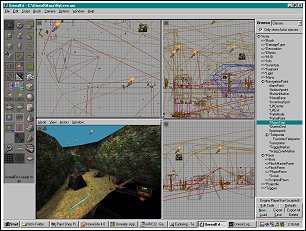 Campbell and Wells found that "the delay between the conception and visualization of design ideas did not provide direct or immediate feedback in the design process," making VR useless in that aspect. Conceptual visualization of the design was relegated to sketches and prerendered walkthroughs of the design.[4] This downtime is a direct cause of disuse of VR in early development. It simply takes too long to visualize a complete, realistic model, make changes and re-render, etc., with current technology, and often simple massings of a model cannot convey enough realism to be useful. Not so with Unreal.
Campbell and Wells found that "the delay between the conception and visualization of design ideas did not provide direct or immediate feedback in the design process," making VR useless in that aspect. Conceptual visualization of the design was relegated to sketches and prerendered walkthroughs of the design.[4] This downtime is a direct cause of disuse of VR in early development. It simply takes too long to visualize a complete, realistic model, make changes and re-render, etc., with current technology, and often simple massings of a model cannot convey enough realism to be useful. Not so with Unreal.
One of the Unreal engine's greatest strength as a design tool is it's integration with the UnrealEd level editor. UnrealEd is a real-time level design tool, optimized for building real-time 3D environments. It is fully integrated with Unreal's rendering engine, offering a WYSIWYG camera view, and immediate display of all lighting, texture placement and geometry operations. UnrealEd also offers single-click playability: even in the midst of the design process, the designer can launch the Unrealty viewer and walk around their building in real-time.[5]
Furthermore, the Unreal engine's maps are not plagued with long BSP tree computational times, nor lightmap and visibility rendering times, as are other 3D game engines, such as id Software's Quake2 engine. A final zoning and BSP computation, while dependant on level size, rarely takes longer than a few minutes, and usually takes only seconds.
2.3. Level of Detail Issues
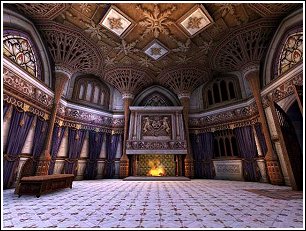 As a model is developed, the complexity increases as the level of realism (textures, lighting, abstract elements, etc.) increases. This increases rendering time, and drops the framerate of a real-time walkthrough quite noticably, in the case of Campbell and Wells' 10,000+ polygon model, from 15Hz to 3-4Hz. This is completely unacceptable for presentational purposes, and makes inspecting the model disorienting and difficult.[4]
As a model is developed, the complexity increases as the level of realism (textures, lighting, abstract elements, etc.) increases. This increases rendering time, and drops the framerate of a real-time walkthrough quite noticably, in the case of Campbell and Wells' 10,000+ polygon model, from 15Hz to 3-4Hz. This is completely unacceptable for presentational purposes, and makes inspecting the model disorienting and difficult.[4]
The Unreal engine does not suffer from these problems, being able to handle over 60,000 polygons in a single level, fully textured and lit. Having been designed in conjunction with a leading-edge, high-detail game, the Unreal engine can handle enormous spaces, with "brushes" of unlimited size, with few guidelines needed to be followed to maintain playability (e.g. fewer than 1200 nodes in view of the player, proper level zoning, etc.). The Unreal engine also supports all major 3D accelerators, with native support for DirectX, OpenGL, Glide, and PowerVR rendering APIs.[5]
Recently added into the engine's already impressive suite of features is model- and texture-based continuous level- of-detail. Independent meshes such as people, animals, furniture, etc. have their polygon count dynamically reduced by the engine in real-time, and textures are scaled down based on distance from the player. This allows for larger textures to be used in levels and on more detailed meshes, without affecting framerate. The complete list of the Unreal engine's features spans seven pages, and is available online.[6]
2.4. Presentation Issues
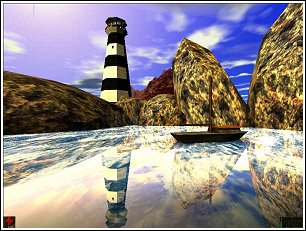 Use of 3D technology to present virtual buildings has traditionally been hampered by long rendering times, and the non-interactiveness of a pre-rendered walkthrough. Movie render times of several days to a week are not unheard of, depending on the complexity of the sequence.[2] Campbell and Wells' design critics would have preferred to tour the virtual building themselves, rather than have to watch a predefined route.[4] At the time, this was impossible due to the expense and complexity of transporting the VR equipment they used. No longer should this be the case.
Use of 3D technology to present virtual buildings has traditionally been hampered by long rendering times, and the non-interactiveness of a pre-rendered walkthrough. Movie render times of several days to a week are not unheard of, depending on the complexity of the sequence.[2] Campbell and Wells' design critics would have preferred to tour the virtual building themselves, rather than have to watch a predefined route.[4] At the time, this was impossible due to the expense and complexity of transporting the VR equipment they used. No longer should this be the case.
The Unreal engine was designed to run on today's consumer PC, preferably with OpenGL or DirectX hardware acceleration. The costs for such an accelerator are now in the US$99 - US$249 range, and inexpensive stereoscopic glasses (Metabyte's eyeSCREAM glasses, retailing for US$99) are available as well. Given the inherent real-time, multi-user nature of the Unreal engine, and the inexpensiveness to optimize a system for running it, being able to tour a virtual building in real-time with colleagues should be a commonplace occurrence, not an impossibility.
3. Unrealty
Beyond being a tool for enhanced design and visualization, the concept of the Unrealty application was an advanced presentational tool for commercial real estate. The flexibility and expandability of the Unreal engine offers several unique possibilities for high-visibility, interactive, collaborative presentations and conferencing.
Expanding upon the base of an architectural firm who has used the Unreal engine to design a 3D model of a client's building, the power of the Unreal engine can now be leveraged to go above and beyond the expectations of the client.
3.1. Increased Realism
Once a 3D model has been created, photorealistic textures up to 2048x2048 pixels in size can be applied to surfaces to increase the perceived detail of an object. This, combined with macrotexture capability (for large-scale detail) and detail texture mapping (for extremely close-up detail) lets a viewer walk up to an object, be it a building facade or a tree, and be simply astounded by the level of complexity and detail in the object.
Expanding upon the base 3D model, the ground surrounding the building could be cultivated (virtually, of course), showing the scenery around the site, be it neighboring buildings, or vast expanses of forest. For a city block, add in cars that drive around and pedestrians that move in and out of neighboring buildings. For a more rural location, perhaps birds flying about, chirping in the distance. All of these actions and events are scriptable in UnrealScript, Unreal's built-in actor manipulation system. Birds can fly around, flock together, and "fly south" if the date is in a winter month. Cars can intelligently circle the block, and pedestrians can walk around, seemingly with purpose.
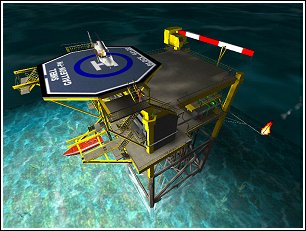 Next comes the environment. Adding an animated or fractal water texture to a nearby pond gives the realism level an extreme boost, as a client looks out a window of a virtual building and sees ducks floating on a pond that ripples. The skybox, Unreal's "sky" portalization method can be dynamically altered, creating the ability to have day realistically change to night, either according the real world's time, or on cue. See buildings at night, and with Unreal's numerous realistic lighting effects, position and design well-lit areas, parking lots and more.
Next comes the environment. Adding an animated or fractal water texture to a nearby pond gives the realism level an extreme boost, as a client looks out a window of a virtual building and sees ducks floating on a pond that ripples. The skybox, Unreal's "sky" portalization method can be dynamically altered, creating the ability to have day realistically change to night, either according the real world's time, or on cue. See buildings at night, and with Unreal's numerous realistic lighting effects, position and design well-lit areas, parking lots and more.
Inside the building, furniture can be added and manipulated in real-time. The Unreal engine's powerful in-game scripting and manipulation allows the addition and removal of any objects not in the level BSP in real-time. The engine's advanced pathnode-based bots allow the summoning of "intelligent office workers" to bustle about a virtual office to show flow patterns and areas with possible congestion issues.
The full power of Unrealty can be leveraged well before the final iteration of a design. The inherent multi-user nature of Unreal technology lets clients connect to an Unreal server using Unrealty client software over the internet, and examine the building in real-time. Converse via text chat, or on a separate phone line as the designers and the clients walk through the building together, pointing out various aspects to be changed or kept. The rapid-development nature of Unreal allows viewers to "leave" the building and be transferred to a "waiting room" while architects make adjustments to the model, then transfer the viewers back in within minutes, not hours or days, allowing true real-time collaboration and creative conceptualization.
Given a base configuration of a Pentium-class workstation running at 200mHz with 64mb RAM, Unreal applications such as Unrealty can be tolerably used. Faster processors, 3D accelerators, etc. all enhance the experience, and it would be in a firm's best interest to make sure that any off-site PCs, such as a client's, were configured to best take advantage of Unreal technology.
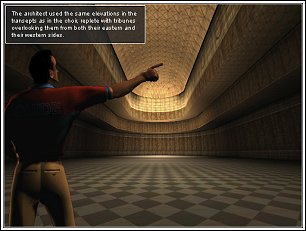 Not every client will need all of this. But Unrealty's concept came about through interviews with a speculative real estate firm, where there's always a building to be sold or leased, and always another one under construction. Clients may reside across the globe, or may want to look around a proposed building site off-hours. The final feature in the Unrealty concept enables all of this, intelligently incorporating all the technologies and features listed above: the Unrealty Tour Guide.
Not every client will need all of this. But Unrealty's concept came about through interviews with a speculative real estate firm, where there's always a building to be sold or leased, and always another one under construction. Clients may reside across the globe, or may want to look around a proposed building site off-hours. The final feature in the Unrealty concept enables all of this, intelligently incorporating all the technologies and features listed above: the Unrealty Tour Guide.
Expanding upon the exemplary pathnode-based artificial intelligence of Unreal (the game)'s "bots", the Unrealty Tour Guide is able to navigate the 3D building effortlessly, and through the placement of scripted triggers, the Tour Guide can point out items of interest, leading the client around the building, or following at his or her behest. Each room or area in the building is "marked," and either scripted into the level content, or detailed in an external data source, is information on the availability, cost, square footage, etc. of every location. On call, the virtual Tour Guide can retrieve and present this information in either spoken or written form, or both, in any language for which translations have been created.
4. Conclusion
The ability to create ultra-realistic virtual worlds, coupled with the technology to present and collaborate on the same worlds from anywhere in the real one, gives the Unrealty concept the greatest benefit over any standalone design tool, or even over using the Unreal engine to enhance design and conceptualization.
Rather than limiting oneself to tools initially directed at the CAD and drafting markets, using the Unreal engine can open up a world of possibilities for architectural design and visualization. This, coupled with the complete Unrealty concept, takes the use of virtual reality technology in architecture and real estate far beyond any product or system currently available.
Acknowledgements:
The "Our House" image is copyright 1999 Ben Golus, from a photorealistic Unreal level of his house. It is used with permission.
The "Amyrlin's Chamber" image is copyright 1999 Legend Entertainment, from their upcoming Unreal engine game, The Wheel of Time (http://www.wheeloftime.com), and is used with permission. Level designers: Scott Dalton, James Parkman, Warren Marshall. Texture artists: Paul Mock, Julie Airoldi, Marc Tetreault, Cindy Wentzell, Robert Wisnewsk.
The "Beaconis Obscura" image is copyright 1999 Staton Richardson, from an award-winning Unreal level he designed. It is used with permission.
The "Offshore Oil Rig" image is copyright 1999 Shell E&P Research & Technical Services, from their SimShell Internship program, for the Shell Learning Center in Holland.
The "Notre Dame Tour Guide" image is copyright 1999 Victor DeLeon, from his paper on Virtual Reality Notre Dame, where the Unrealty Tour Guide technology is also being used. It is used with permission.
References:
[1] Berger, Warren. "Future Quest: Go Where No Real Estate Company Has Gone Before." Real Estate Today. January 1994 (15-18).
[2] Shappy, Wayne. Senior CAD Technician, Ames Corporation, Bangor, Maine, USA. Personal interview. April 1999.
[3] Grant, Tony. Principal, KHTG Design Associates, Vancouver, British Columbia, Canada. Personal interview. April 16, 1999, followup April 26 1999.
[4] Campbell, Dace A. and Wells, Maxwell. "A Critique of Virtual Reality in the Architectural Design Process." Available: http://www.hitl.washington.edu/publications/r-94-3/. Human Interface Technology Laboratory, University of Washington, Seattle, Washington, USA. 1994.
[5] Sweeney, Tim. "Unreal Technology Features." Available: http://unreal.epicgames.com/UnrealFeatures.htm. Epic Games, Inc. June 29, 1998
[6] Sweeney, Tim. "Unreal Technology Announcements Page." Available: http://unreal.epicgames.com/news.htm. Epic Games, Inc. March 19, 1999, April 15, 1999.
[7] Richardson, Staton. Personal interview. April 30, 1999.
[8] Ellis, Lucas. Personal interview. April 30, 1999.
[9] Berry, H. Robert, Jr. Visiting Researcher, Virtual Systems Laboratory, Gifu University, Japan. Personal interview. April 14, 1999.
 This scene was the future of real estate, rapidly approaching sellers thanks to the "fiber-optic information superhighway," and it would be only a few years before everyone sold houses this way. Over five years later, this scene has yet to be realized, particularly in the realm of commercial real estate development.
This scene was the future of real estate, rapidly approaching sellers thanks to the "fiber-optic information superhighway," and it would be only a few years before everyone sold houses this way. Over five years later, this scene has yet to be realized, particularly in the realm of commercial real estate development.


